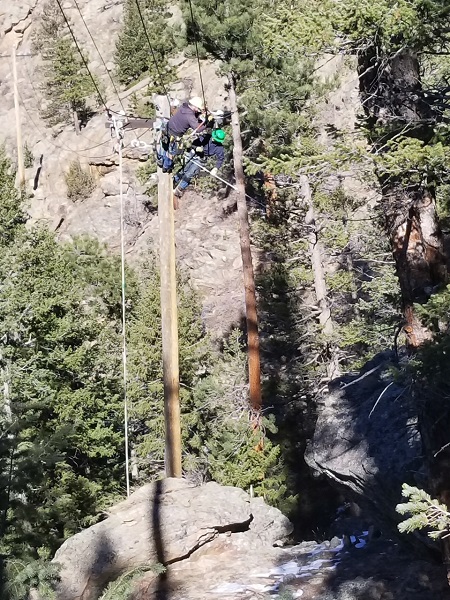Wildfire Mitigation
Protecting Estes Park's Power and Communications Infrastructure
 Most of Estes Park Power and Communications' 300 square-mile service area is located in forested, mountainous areas that are difficult to access, putting it at high risk for wildfire. Power and Communications makes wildfire prevention and mitigation a priority.
Most of Estes Park Power and Communications' 300 square-mile service area is located in forested, mountainous areas that are difficult to access, putting it at high risk for wildfire. Power and Communications makes wildfire prevention and mitigation a priority.
Following the historic fires in 2020, Power and Communications developed and implemented a Wildfire Mitigation Plan detailing how the department will mitigate the risks of wildfire ignition in its service area. The Wildfire Mitigation Plan describes the proactive strategies and programs that Power and Communications had in place or developed to minimize the potential of the electric infrastructure to cause wildfires.
This plan includes descriptions of the various programs, practices, and procedures that have been implemented, takes a holistic look at wildfire mitigation, and will continually evolve in an effort for continuous improvement.
Power and Communications' Wildfire Mitigation Plan and operations were featured as a case study in a white paper published by Tantalus Systems, the Town's AMI platform.
Wildfire Risks
Power and Communications has identified the primary wildfire risk drivers for the service area as follows:
- The extent of vegetation and vegetation type
- Vegetation health
- Extended drought conditions
- High winds
- Terrain
- Lightning
- Area access
The main risk drivers associated with the system which could spark a wildfire have been identified as follows:
- Contact from objects (trees, vehicles, animals, etc.)
- Equipment failure
- Wire-to-wire contact
- Insulator failure or contamination
- Equipment contact (e.g., during construction and maintenance or by outside entities)
Utility Mitigation Strategies
The goals of the utility mitigation strategies are to reduce risk and improve the resiliency of the electric system. The primary elements of Power and Communications' wildfire mitigation strategy are:
- Operational practices
- Situational awareness - crew supervisors integrate wildfire risk assessment with infrastructure system data and weather conditions while planning day-to-day work.
- Red Flag/Extreme Fire conditions - department staff implements "one-shot" settings for the highest risk sections of power lines on the system using various system protection devices. This means that the line will de-energize after seeing a single fault.
- Vegetation management - in addition to reducing wildfire risk, the vegetation management program enables Power and Communications to protect the environment, provide for the public's safety, and ensure economic and reliable electric utility services.
- System hardening - department staff have evaluated the electric system design, equipment, and construction standards, focusing on reliability improvements and reducing ignition sources. One major mitigation and reliability project is replacing bare copper conductors with insulated wire and fuses with automated reclosers. The Electric Projects page highlights these ongoing efforts.
Resident Mitigation Strategies
Call Before You Dig - Always call 811 before planting or digging on your property! With 48 hours' notice, you may also request a FREE temporary disconnect (or line drop) and Estes Park Power and Communications will de-energize your line so your contractor can safely trim back your trees.
Trees of Interest - Any tree on or off the right-of-way with the potential to contact an electric supply line is considered a tree of interest. A tree of interest can include (but is not limited to) a tree that is decaying/dead, a diseased tree, a cracked tree, a leaning tree, or a tree with root damage. Trees of interest should be topped or trimmed below line-height or removed. We'll be happy to meet you on-site to review them and work with you to find the best mitigation solution. Email us at electrictrouble@estes.org or call Tyler Boles, Crew Supervisor, at 970-577-3607.
The Estes Valley Community Wildfire Protection Plan Update began in the summer of 2021 and provides numerous resources to mitigate and prepare for fires to residents, homeowners, and guests of both the Estes Valley and surrounding areas. The final plan is available here.
The Estes Valley CWPP Story Map give the context of the fire environment in the area, the values at risk, and hazard and risk assessments.
The resources for mitigation in the Home Ignition Zone, in particular, overlap with maintaining customer power reliability since this zone includes overhead electric service lines.
The Estes Valley CWPP Update will support and encourage collaboration among land managers and the community to better understand the unique resources, fuels, topography, climatic and structural characteristics in the Estes Valley; and to prioritize and plan fuels treatments to mitigate fire risks. The Town and Power and Communications will be active participants in these ongoing efforts.